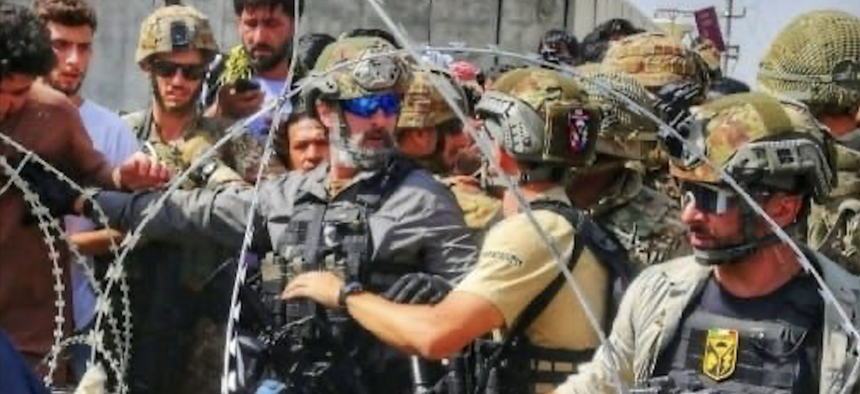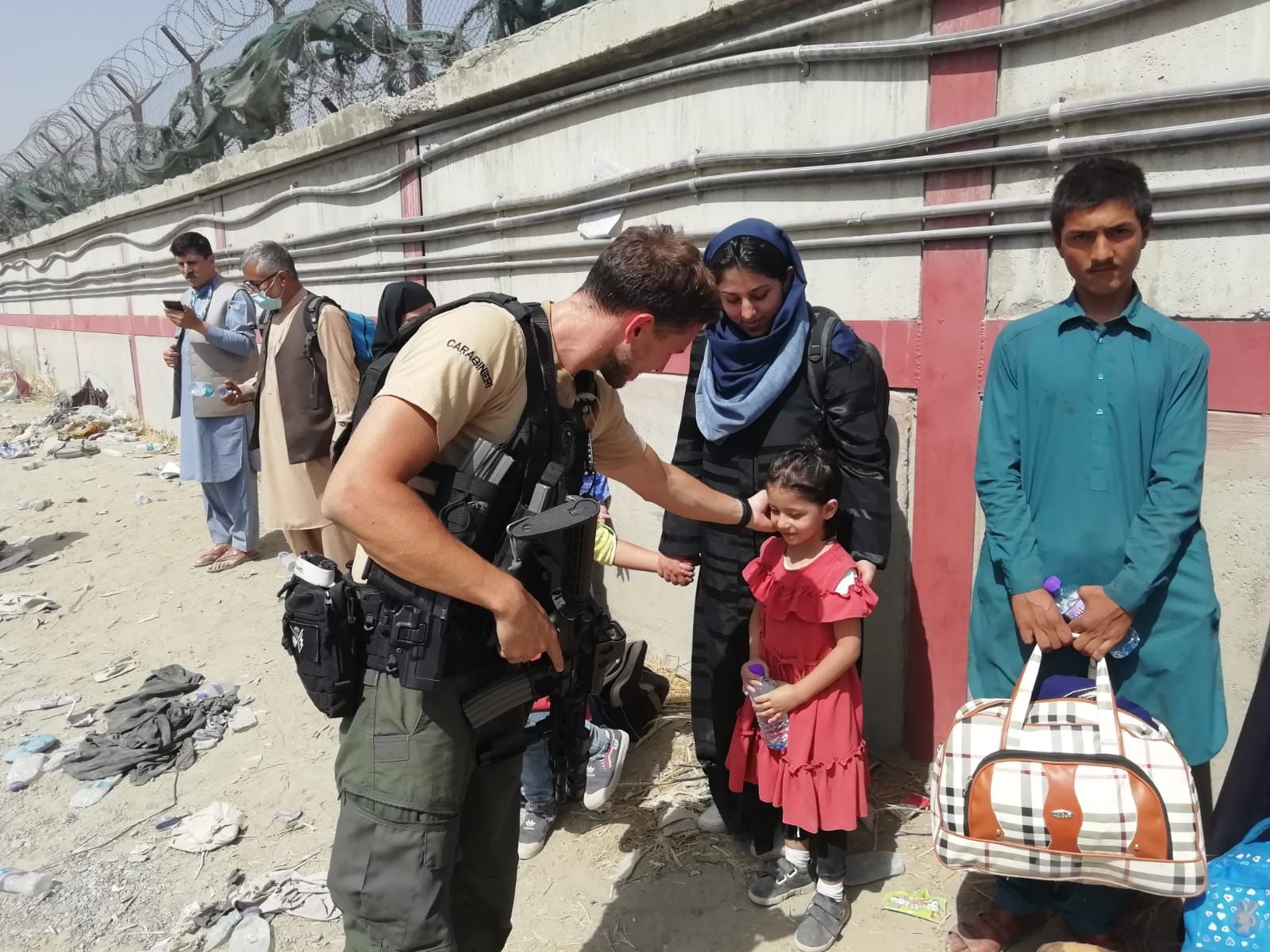
Carabinieri help with the evacuation at Kabul Airport. 2nd Mobile Brigade, Carabinieri
Italy’s Carabinieri Were the Perfect Force for the Kabul Evacuation
The soldier-policemen of this hybrid outfit went outside the wire to bring thousands to safety.
Some 5,000 Afghans rescued, plus Italians and citizens of allied countries: a spectacular achievement by Italy during the evacuation from Hamid Karzai International Airport. To handle the extraordinarily complex and dangerous task, Rome had dispatched some of its very best soldiers and Carabinieri. Other countries can learn from Italy’s green-and-blue Carabinieri—a hybrid police-and-military force—because the world will see plenty more of these highly complex and dangerous situations short of war.
“We were in Afghanistan from Day 1,” Brig. Gen. Stefano Iasson told me. “And when it was decided the allied forces would leave, it was clear that we’d help with the evacuation as well.”
Iasson commands the Carabinieri’s 2nd Mobile Brigade, an elite unit that the Italian government habitually calls upon for particularly dangerous assignments abroad. Members of the 2nd Mobile Brigade are regularly deployed in unstable locations such as Tripoli, Mogadishu, and Beirut, or to guard Italy’s embassies in particularly perilous capitals such as Islamabad and Caracas.
All that made the 2nd Mobile Brigade an obvious choice for the highly complex and dangerous evacuation of Italians, Afghans, and other nationals from Kabul. When the last Italian contingent—comprising Carabinieri, Italian Army soldiers, as well as Italian consul Tommaso Claudi and Amb. Stefano Pontecorvo, NATO’s senior civilian representative—had left Hamid Karzai International Airport, the Italians had rescued not just their own citizens but nearly 5,000 Afghans as well. That’s the highest number of any EU member state. France evacuated 2,600 Afghans, and Germany brought some 4,100 to safety. The United States evacuated more than 31,000 Afghans—but it was, after all, primarily America’s war.

Carabinieri help with the evacuation at Kabul Airport. Credit: 2nd Mobile Brigade, Carabinieri
The Carabinieri at Kabul airport came from the 2nd Mobile Brigade’s 1st Paratrooper Regiment, Tuscania. With virtually no use of force, but with plenty of ingenuity, these young men—some of whom were on their sixth deployment to Afghanistan—worked out a simple but effective scheme that was crucial in identifying to-be-rescued Afghans.
“They went out around in the areas outside the airport, including outside Abbey Gate, to find these people, including children and old women,” Iasson said. “The reason they were able to find so many is in this state of general confusion was that they had worked out a scheme. Those needing to be evacuated had been instructed by us to dress in a certain way so we could recognize them, and the Carabinieri communicated with them using Whatsapp, and found their locations via Google Maps. It was a simple and creative method. But the Carabinieri doing this were extremely skilled.”
At the airport, Pontecorvo—who led the civilian NATO staff in charge of coordinating the massive airlift—kept a constant eye on the evacuation efforts, both those of Italy and other countries.
“The Italians going outside Abbey Gate to retrieve people who had helped Italy was no mean feat,” the ambassador said. “There were others as well, but the Carabinieri were the backbone. “They had special signals, special colors to wear. But the big advantage the Carabinieri had is that they have skills in crowd control. Other special forces don’t have those skills.”
Precisely thanks to such skills, the Carabinieri had been as much in demand during Afghanistan’s reconstruction phase as they were during the final evacuation. That’s because the Carabinieri are that unusual hybrid of soldier and police officer. Only a few other countries, notably France and Spain, have such gendarmeries, and it has been many years since the last gendarmerie was created. Liberal democracies often dismiss calls for gendarmerie forces with concerns about the mixing of military and policing duties. But for gendarmerie countries, their forces are exceptionally useful. As I’ve documented in past articles, the Carabinieri handle tasks from community policing to counter-terrorism duties and teaching of partner forces in unstable countries. And exactly because there are so few forces with the dual skills of soldering and policing, the Carabinieri’s 2nd Mobile Brigade is in extremely high demand for foreign assignments as part of NATO, the UN, and the European Union.
Looking back at Afghanistan, where the 2nd Mobile Brigade had a presence until that final flight, Iasson said, “David Petraeus was very keen on the Carabinieri. He saw how we trained the police in Herat. The Brits too were constantly amazed at how we’re both soldiers and police officers. But it’s not just about the identity but about the things that dual training allows you to do. We do stability policing, we train partner forces, we do counter-terrorism. The French have their Gendarmerie, but it’s less active on allied assignments.”
Last fall, I visited the 2nd Mobile Brigade, which is based in the northern Italian city of Livorno, to learn how the Carabinieri learn those dual skills. Its newest members arrive at the brigade already trained as regular Carabinieri, which means they primarily have skills on community policing and criminal investigations, including ones with foreign links. About 30 percent of applicants to the 2nd Mobile Brigade are accepted for training, which lasts for nine months. I saw the young soldier-policemen practice hostage rescue, crowd control, and terrorism response, but also how conduct policing in environments that aren’t at war but where stability needs to be created so society can function. The latter – known as stability policing – is a highly complex task. Carry lots of equipment and it creates a barrier with the locals, or even hostility. Carry little equipment and the risk increases. It’s no surprise that Italy hosts not just NATO’s Stability Policing Center of Excellence but the EU Gendarmerie Force and the Center of Excellence for Stability Police Units, or CoESPU, as well.
All the troops conducting the evacuations from Kabul performed outstandingly in a complex and dangerous environment. 13, of course, paid with their lives. But the vast majority of those troops were—well, soldiers. The evacuation won’t be the last dangerous situation short of war facing Western countries. Indeed, such situations are proliferating. Short of establishing their own gendarmeries, countries would do well to at least provide their soldiers and police officers with the hybrid skills that have stood the Carabinieri in good stead.




